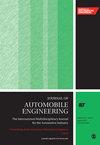Machine learning-based real time identification of driver posture during driving
IF 1.5
4区 工程技术
Q3 ENGINEERING, MECHANICAL
Proceedings of the Institution of Mechanical Engineers Part D-Journal of Automobile Engineering
Pub Date : 2024-07-30
DOI:10.1177/09544070241265398
引用次数: 0
Abstract
The detection of driver distractions is exceptionally important for driving safety. Driver distraction can originate from various sources such as external tasks (e.g., texting or eating) or mental states (e.g., sleepiness, tiredness, anger, and tension). To detect these conditions, most of the previous studies were based on vision-based techniques. These techniques are affected by environmental factors (e.g., day, night, and facial accessories such as glasses and hats). However, the steering wheel is an interface that provides a direct relationship between the driver and vehicle. The driver’s interaction can effectively reflect this behavior and mental state. This study introduced a new method for detecting driver distractions by utilizing force/torque (F/T) sensor data extracted from the steering wheel. An experimental setup was designed and developed to measure the accuracy of the proposed method. To validate the strategy, a machine learning-based algorithm was developed. It demonstrated remarkable performance in determining the position of the driver’s hand on the steering wheel and in inferring with high precision the hand the driver uses to operate the vehicle. The method produced accurate results in all the grip ranges that could be held by the driver within the range of 0°–360°. The support vector machine (SVM) method was used in machine learning. It predicted with a 91.1% accuracy rate.基于机器学习的驾驶员驾驶姿态实时识别系统
检测驾驶员分心对驾驶安全异常重要。驾驶员分心的原因多种多样,如外部任务(如发短信或吃东西)或精神状态(如困倦、疲惫、愤怒和紧张)。为了检测这些情况,以往的研究大多基于视觉技术。这些技术会受到环境因素(如白天、黑夜以及眼镜和帽子等面部配饰)的影响。然而,方向盘是一个在驾驶员和车辆之间提供直接关系的界面。驾驶员的互动可以有效反映这种行为和心理状态。本研究利用从方向盘提取的力/扭矩(F/T)传感器数据,引入了一种检测驾驶员分心的新方法。研究人员设计并开发了一套实验装置,用于测量拟议方法的准确性。为了验证该策略,还开发了一种基于机器学习的算法。该算法在确定驾驶员的手在方向盘上的位置以及高精度推断驾驶员用来操作车辆的手方面表现出色。在 0°-360° 范围内,该方法在驾驶员可以握住的所有握把范围内都能得出准确的结果。在机器学习中使用了支持向量机(SVM)方法。其预测准确率为 91.1%。
本文章由计算机程序翻译,如有差异,请以英文原文为准。
求助全文
约1分钟内获得全文
求助全文
来源期刊

CiteScore
4.40
自引率
17.60%
发文量
263
审稿时长
3.5 months
期刊介绍:
The Journal of Automobile Engineering is an established, high quality multi-disciplinary journal which publishes the very best peer-reviewed science and engineering in the field.
 求助内容:
求助内容: 应助结果提醒方式:
应助结果提醒方式:


